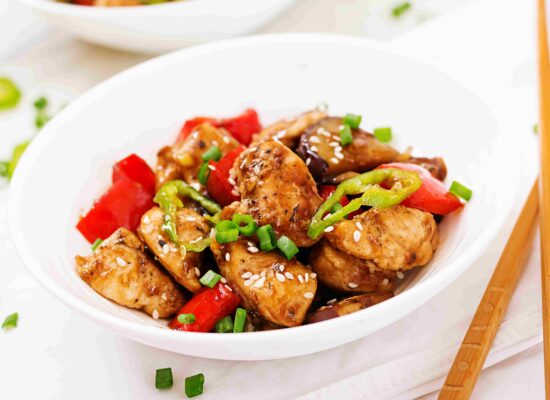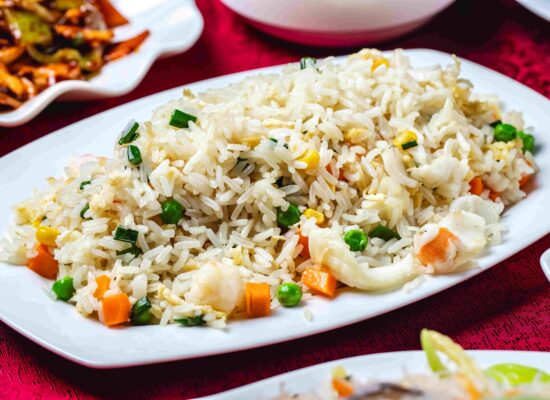Kung Pao Chicken with a Flavorful Twist
Kung Pao Chicken is a deliciously spicy and savory Chinese dish that blends tender chicken with a mix of peanuts, vegetables, and a rich, flavorful sauce. This classic Chinese recipe is perfect for a satisfying meal that you can make at home in just a few easy steps. Here’s how to prepare it to impress your family or guests.
Ingredients
For the Chicken:
- 1 lb boneless, skinless chicken breast, cubed
- 1 tablespoon soy sauce
- 1 tablespoon rice vinegar
- 1 teaspoon cornstarch
- Salt and pepper, to taste
For the Kung Pao Sauce:
- 3 tablespoons soy sauce
- 1 tablespoon hoisin sauce
- 1 tablespoon rice vinegar
- 1 tablespoon sugar
- 1 tablespoon cornstarch
- 1/2 cup chicken broth or water
- 1 tablespoon sesame oil
For the Stir-Fry:
- 1/2 cup roasted peanuts
- 3-4 dried red chilies
- 2 tablespoons vegetable oil
- 1 red bell pepper, diced
- 1 green bell pepper, diced
- 2 green onions, chopped
- 1 tablespoon minced garlic
- 1 tablespoon minced ginger
Instructions
Prepare the Kung Pao Sauce:
Combine Ingredients: In a small bowl, mix the soy sauce, hoisin sauce, rice vinegar, sugar, cornstarch, and chicken broth until smooth. Set aside.
Adjust Flavor: Taste and adjust the sweetness or saltiness of the sauce to suit your preference.
Marinate the Chicken:
Marinate: In a medium bowl, toss the chicken with soy sauce, rice vinegar, and cornstarch. Season lightly with salt and pepper. Let it marinate for about 10-15 minutes to absorb the flavors.
Cook the Chicken:
Heat Oil: In a large skillet or wok, heat the vegetable oil over medium-high heat. Add the dried red chilies and stir-fry for a few seconds until they become fragrant. This step infuses the oil with a subtle spice, creating a flavorful base for the dish.
Cook Chicken: Add the marinated chicken to the skillet and stir-fry until it’s golden brown on the outside and fully cooked on the inside, about 4-5 minutes. Remove the chicken from the skillet and set aside.
Stir-Fry the Vegetables:
Sauté Aromatics: In the same skillet, add a bit more oil if needed, then add the garlic and ginger. Sauté for about 1 minute until fragrant, being careful not to let them burn.
Add Peppers and Green Onions: Add the diced red and green bell peppers, along with the green onions. Stir-fry for 2-3 minutes until the vegetables start to soften but still have a bit of crunch.
Combine Everything:
Return Chicken to Skillet: Add the cooked chicken back to the skillet with the vegetables.
Pour Sauce: Pour the Kung Pao sauce over the chicken and vegetables. Stir well to coat everything evenly, and let it cook for another 1-2 minutes until the sauce thickens.
Add Peanuts: Stir in the roasted peanuts for extra crunch and flavor.
Serve:
Plate and Garnish: Serve your Kung Pao Chicken hot, garnished with additional green onions if desired.
Serve with Rice: This dish pairs perfectly with steamed white or brown rice, which absorbs the delicious sauce and balances the flavors.
Tips
Adjusting Spice Levels:
If you prefer a milder dish, reduce the number of dried red chilies. For more heat, add a pinch of crushed red pepper flakes.
Authentic Chinese Flavor:
To add extra authenticity, you can incorporate a bit of Sichuan peppercorn, which adds a unique, numbing spice characteristic of Sichuan cuisine.
Make it Vegetarian:
Swap the chicken with firm tofu or even cauliflower for a vegetarian twist that retains the dish’s signature flavors.
Storing Leftovers:
Kung Pao Chicken stores well in the refrigerator for up to 3 days. Reheat it in a skillet to maintain its texture.
Enjoy your homemade Kung Pao Chicken with the perfect balance of savory, sweet, and spicy flavors that make this dish a Chinese favorite.





























